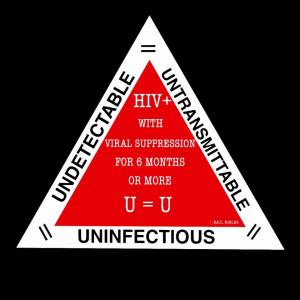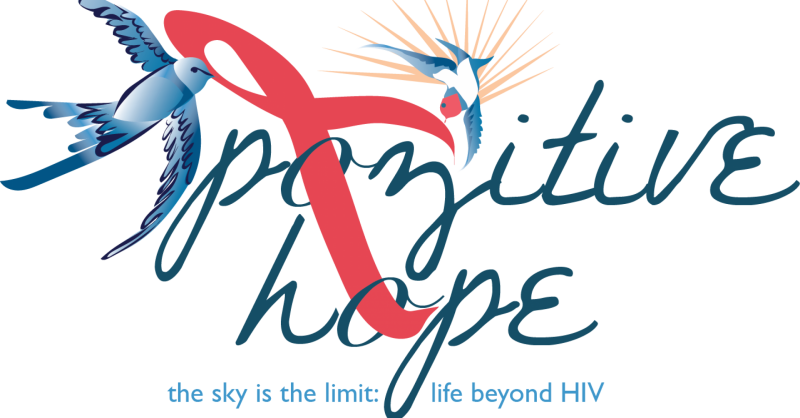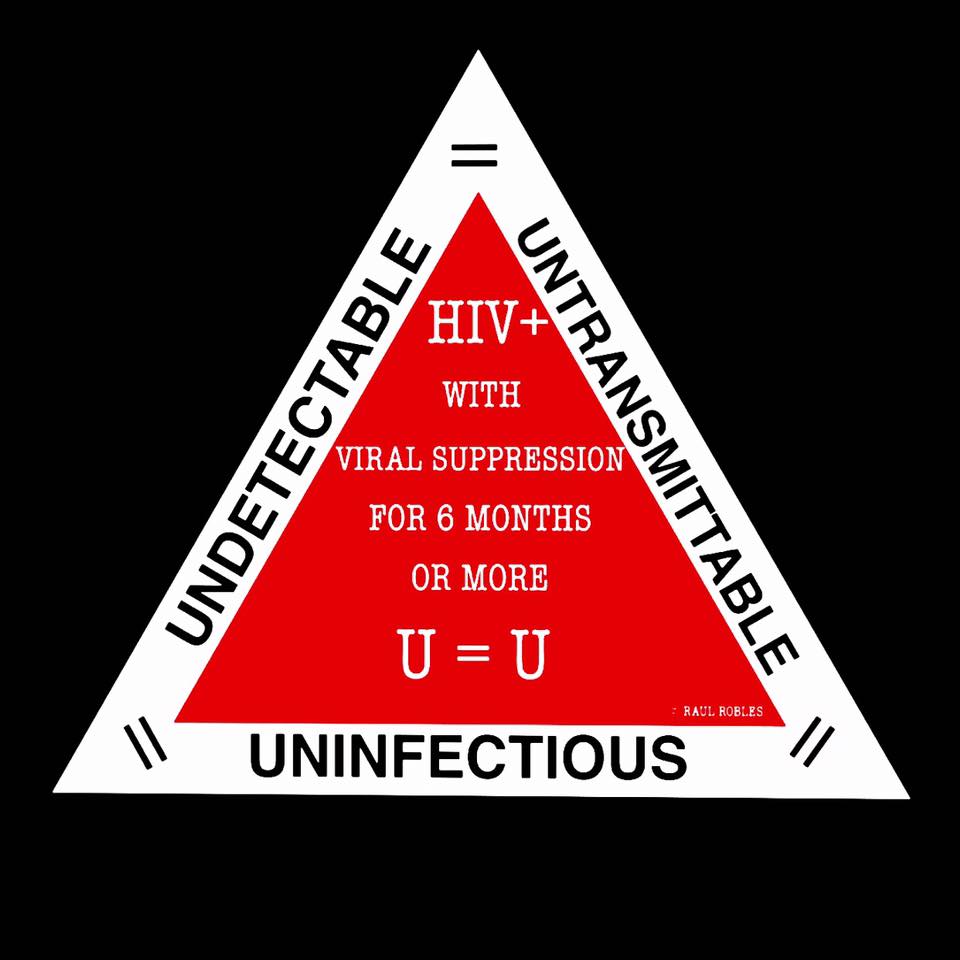
RISK OF SEXUAL TRANSMISSION OF HIV FROM A PERSON LIVING WITH HIV WHO HAS AN UNDETECTABLE VIRAL LOAD
Messaging Primer & Consensus Statement
There is now evidence-based confirmation that the risk of HIV transmission from a person living with HIV (PLHIV), who is on Antiretroviral Therapy (ART) and has achieved an undetectable viral load in their blood for at least 6 months is negligible to non-existent. While HIV is not always transmitted even with a detectable viral load, when the partner with HIV has an undetectable viral load this both protects their own health and prevents new HIV infections.[i]
However, the majority of PLHIV, medical providers and those potentially at risk of acquiring HIV are not aware of the extent to which successful treatment prevents HIV transmission.[ii] Much of the messaging about HIV transmission risk is based on outdated research and is influenced by agency or funding restraints and politics which perpetuate sex-negativity, HIV-related stigma and discrimination.
The consensus statement below, addressing HIV transmission risk from PLHIV who have an undetectable viral load, is endorsed by principal investigators from each of the leading studies that examined this issue. It is important that PLHIV, their intimate partners and their healthcare providers have accurate information about risks of sexual transmission of HIV from those successfully on ART.
At the same time, it is important to recognize that many PLHIV may not be in a position to reach an undetectable status because of factors limiting treatment access (e.g., inadequate health systems, poverty, racism, denial, stigma, discrimination, and criminalization), pre-existing ART treatment resulting in resistance or ART toxicities. Some may choose not to be treated or may not be ready to start treatment.
Understanding that successful ART prevents transmission can help reduce HIV-related stigma and encourage PLHIV to initiate and adhere to a successful treatment regimen.
The following statement has been endorsed by:
-
Dr. Michael Brady – Medical Director of Terrence Higgins Trust and Consultant HIV Physician, London, UK
-
Dr. Myron Cohen – Principal Investigator, HPTN 052; Chief, Division of Infectious Diseases, UNC School of Medicine, North Carolina, USA
-
Dr. Demetre C. Daskalakis, MPH – Assistant Commissioner, Bureau of HIV/AIDS Prevention and Control New York City Department of Health and Mental Hygiene, New York, USA
-
Dr. Andrew Grulich – Principal Investigator, Opposites Attract; Head of HIV Epidemiology and Prevention Program, Kirby Institute, University of New South Wales, Australia
-
Dr. Jens Lundgren – Co-principal Investigator, PARTNER; Professor, Department of Infectious Diseases, Rigshospitalet, University of Copenhagen, Denmark
-
Dr. Julio Montaner – Director of the British Columbia Centre for Excellence in HIV/AIDS; Director of IDC and Physician Program Director for HIV/AIDS PHC, Vancouver BC, Canada
-
Dr. Pietro Vernazza – Executive Committee, PARTNER; Author, Swiss Statement 2008, Update 2016; Chief of the Infectious Disease Division, Cantonal Hospital in St. Gallen, Switzerland
Organizational endorsements include:
People living with HIV on ART with an undetectable viral load in their blood have a negligible risk of sexual transmission of HIV. Depending on the drugs employed it may take as long as six months for the viral load to become undetectable. Continued and reliable HIV suppression requires selection of appropriate agents and excellent adherence to treatment. HIV viral suppression should be monitored to assure both personal health and public health benefits.
NOTE: An undetectable HIV viral load only prevents HIV transmission to sexual partners. Condoms also help prevent HIV transmission as well as other STIs and pregnancy. The choice of HIV prevention method may be different depending upon a person’s sexual practices, circumstances and relationships. For instance, if someone is having sex with multiple partners or in a non-monogamous relationship, they might consider using condoms to prevent other STIs.
“NEGLIGIBLE” = so small or unimportant as to be not worth considering; insignificant.
ADDITIONAL EXPERT QUOTES, SOURCES, AND EXPLANATIONS [iii]
1. “If you are durably virologically suppressed you will not transmit to your partner… I’ll say this again, for somebody who is in a discordant couple, if the person [with HIV] is virologically suppressed, ‘durably’ –there is no virus in their system, hasn’t been for several months — your chance of acquiring HIV from that person is ZERO. Let’s be clear about that: ZERO. If that person the next day stops therapy for two weeks and rebounds, your chance goes up. That’s why we talk about ‘durable’ viral suppression…You’re as durably virologically suppressed as good as your adherence”. Dr. Carl Dieffenbach, Director of the Division of AIDS, NIH. NIH Video interview (November 11, 2016)
2. “When an HIV positive person first starts on treatment, it takes a few months before viral growth is completely suppressed. During that short window of time, the couple should use condoms. Alternatively, the HIV negative partner might use antiretroviral agents as pre-exposure prophylaxis [PrEP].” Dr. Myron Cohen Chief, Division of Infectious Diseases, UNC School of Medicine, North Carolina, USA; Principal Investigator, HPTN 052. POZ magazine (September 26, 2016)
3. Suppressing the viral load of a person living with HIV to undetectable levels “not only saves their lives but prevents them from infecting others. So the higher percentage of people who are on treatment, in care and get their viral loads to undetectable, the closer you get to literally ending the epidemic.” Dr. Anthony Fauci, Director of NAID, NIH. NIH Video Interview (August, 2016)
4. “..Once you begin therapy, you stay on therapy, with full virologic suppression you not only have protection from your own HIV….. but you also are not capable of transmitting HIV to a sexual partner. With successful antiretroviral treatment, that individual is no longer infectious.” Dr. Carl Dieffenbach, Director of the Division of AIDS, National Institutes of Health. NIH Videointerview (August, 2016)
5. “We can now say with confidence that if you are taking HIV medication as prescribed, and have had an undetectable viral load for over six months, you cannot pass on HIV with or without a condom.” Dr. Michael Brady, Medical Director, Terrence Higgins Trust, London, England (July 2016)
6. “The force of evidence in both real world and clinical trial experience confirms that individuals with suppressed viral loads have a negligible risk of transmitting HIV. Treatment as prevention, pre-exposure prophylaxis, and traditional prevention measures, like condoms, make up an HIV prevention toolkit based in harm-reduction that allows individuals to make personalized and enlightened decisions to both maintain their health and prevent HIV and STI transmission.” Dr. Demetre C Daskalakis, MPH – Assistant Commissioner, Bureau of HIV/AIDS Prevention and Control New York City Department of Health and Mental Hygiene (July 2016)
7. “Does this work over a long period of time for people who are anxious to be suppressed? The answer is absolutely yes, we now have 10,000 person years (of follow-up) with zero transmissions from people who are suppressed.” Dr. Myron Cohen. Medpage; NEJM. (July 2016)
8. “Among serodifferent heterosexual and MSM couples in which the HIV-positive partner was using suppressive ART and who reported condomless sex…there were no documented cases of within-couple HIV transmission” among 58,000 condomless sex acts. Reporting on PARTNER study Dr. Alison Rodger, et al. JAMA. (July 2016)
9. “These results are simple to understand – zero transmissions from over 58,000 individual times that people had sex without condoms…[PARTNER study] provides the strongest estimate of actual risk of HIV transmission when an HIV positive person has undetectable viral load – and that this risk is effectively zero.“ Simon Collins, Steering Committee, PARTNER, i-BASE (July 2016)
10. “The [Swiss] statement [was the first position statement that] addressed the infectiousness of an HIV-positive person once the virus was stably suppressed for at least 6 months with ART. [T]he [Swiss Federal Commission for AIDS-related Issues] felt, based on an expert evaluation of HIV transmission risk under therapy, that the risk of HIV transmission in such a situation was negligible.” Dr. Pietro Vernazza, chief of the Infectious Disease Division, Cantonal Hospital in St. Gallen, Switzerland; Executive Committee, PARTNER Swiss Medical Weekly (Jan. 2016, confirming the original 2008 Swiss statement)’
11. “[T]he HPTN 052 study saw only cases of transmission during ART that occurred shortly (days) after the initiation of therapy. If only transmissions after the first six months of ART are considered (as stipulated in the Swiss statement) the efficacy would have been 100% with a transmission risk of zero.” Dr. Pietro Vernazza, Swiss Medical Weekly (Jan. 2016)
12. “We have…rigorous confirmation that treatment prevents the spread of HIV and improves the health of infected people.” Dr. Thomas R. Frieden, Center for Disease Control Director, USA New England Journal of Medicine sourcing HPTN 052 & PARTNER studies (Dec. 2015)
13. “If people are taking their pills reliably and they’re taking them for some period of time, the probability of transmission in this study is actually zero.” Dr. Myron Cohen, Chief, Division of Infectious Diseases, UNC School of Medicine, North Carolina, USA; Principal Investigator, HPTN 052 Interview with plus (August, 2015)
14. “[People with HIV] will not pass on the infection, if the virus is undetectable, to their partners…” Professor David Cooper – Director of the Kirby Institute for Infection and Immunity in Society. University of NSW, Australia; ABC AU interview (May 2015)
15. “When you treat a person who is HIV infected you render them no longer contagious. Over a period of years that benefit is further realized… Sexual relationships can be much safer because [treatment] suppresses transmission. There is a societal benefit, a public health benefit, an altruistic benefit. ” Dr. Myron Cohen, Chief, Division of Infectious Diseases, UNC School of Medicine, North Carolina, USA; Principal Investigator, HPTN 052 At IAS Meeting, (2015)
16. When asked what the study tells us about the chance of someone with an undetectable viral load transmitting HIV, presenter Alison Rodger said: “Our best estimate is it’s zero.” Reporting on PARTNER study interim results. Dr. Alison Rodger, University College London, United Kingdom; Lead Author PARTNER, NAM -AIDSMap (March, 2014)
17. People living with HIV “are leading lives that are normal in quality and length. With effective treatment, they are not infectious.” Health care workers on effective HIV treatment are “totally safe.” Professor Dame Sally Davies, Chief Medical Officer, England. The Telegraph (Aug. 2013)
18.“In reality, if you give the treatment the opportunity to get on with its work, you will have zero transmission”. Dr. Julio Montaner, Director of the British Columbia Centre for Excellence in HIV/AIDS; Director of IDC and Physician Program Director for HIV/AIDS PHC: TED Talk referring to HPTN 052 (Nov. 2011).
[i] Much of the current prevention messaging refers to this as Treatment as Prevention or TasP. As of the writing of this primer, there have been no confirmed cases of HIV transmission from a person with an undetectable viral load in any studies. The official cut-off point for an undetectable viral load as defined by the WHO ranges from <50 copies/ml in high income countries to <1,000 copies/ml in low to middle-income countries. For the purposes of this statement, an undetectable viral load is defined as under <200 copies/ml.
[ii] Only a small proportion of HIV-positive people in a large US treatment study regarded themselves as non-infectious after up to three years on antiretroviral therapy (ART), and a third of participants regarded their chance of infecting a partner as still ‘high’, even though only 10% of participants actually had a detectable viral load.” NAM- AIDSMap (2016)
[iii] Acknowledgements: In addition to PAC’s Founding Task Force, Professor Carrie Foote (Indiana University-Indianapolis) and Edwin Bernard (HIV Justice Network), reviewed and provided valuable input on the Primer.

